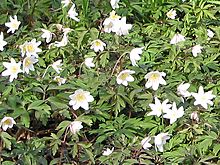Hobbs Quarry SSSI, Longhope facts for kids
| Site of Special Scientific Interest | |

Wood anemones (Anemone nemorosa) in a Forest of Dean wood
|
|
| Area of Search | Gloucestershire |
|---|---|
| Coordinates | 51°52′25″N 2°26′37″W / 51.873683°N 2.443701°W |
| Interest | Biological/Geological |
| Area | 1 hectare |
| Notification | 1966 |
Hobbs Quarry, Longhope is a special place in Gloucestershire, England. It's a 1-hectare (about 2.5 acres) area that's important for both its unique rocks and its wildlife. It was first recognized as a Site of Special Scientific Interest (SSSI) in 1966.
You can find it between the villages of Longhope and Dursley Cross, right in the beautiful Forest of Dean. Nearby are Kiln Wood and Coleman's Wood. The Gloucestershire Wildlife Trust takes care of this amazing place. It's even listed as a 'Key Wildlife Site' because of how important it is for nature.
This quarry was once much bigger, stretching about a mile into Kiln Wood. Sadly, parts of it were damaged by being used as a landfill or by illegal dumping. To protect it, the Nature Conservancy Council made it an SSSI. The Gloucestershire Wildlife Trust bought the site in 1981 to help restore it.
Contents
A Look Back: The Quarry's History
Quarrying at Hobbs Quarry started a long time ago, in the 1600s, and continued until at least the late 1800s. Old maps from 1889 show it was already a working quarry then.
What Was Mined Here?
The quarry was used to dig out limestone. This limestone was then burned to make 'burning-lime'. You can still see an old kiln (a special oven) at the southern end of the site, which was used for this process.
Ancient Rocks and Fossils
When the quarrying stopped, it left behind amazing rock formations. These rocks are from the Silurian period, about 400 million years ago! Back then, this whole area was covered by warm seas.
You can see special round shapes in the rocks called 'ballstones'. These are actually ancient algal and coral reefs. Layers of limestone drape over these reefs, showing how they formed over time. These rocks are full of different fossils, like corals, brachiopods (shellfish), trilobites (ancient sea creatures), and crinoids (sea lilies). This makes Hobbs Quarry a fantastic place for geology students to learn.
Why Was Lime Important?
The lime produced here was very useful. It was used to improve the soil in the Forest of Dean, which is often acidic. Farmers would add lime to their fields to help crops grow better. Lime was also used to make mortar, which is like glue for building with stones and bricks.
When limestone was burned in the kiln, it created a dangerous substance called quicklime. This quicklime was then mixed with water to make hydrated lime, which was safer to transport and use.
Plants and Trees of Hobbs Quarry
After the quarry stopped working, nature quickly started to reclaim the land. The quarry floor and walls were soon covered by plants.
Common Plants and Ferns
You can find common plants like ash trees, brambles, and wild clematis (also known as old man's beard). The damp quarry walls are home to moss and hart's-tongue fern.
Ancient Woodland Species
The presence of small-leaved lime trees is a special clue. It tells us that the quarry was once part of the nearby Coleman's Wood, which is an ancient woodland. Historically, these lime trees were coppiced, meaning they were cut back regularly to encourage new growth.
Other trees you might see include pedunculate oak, silver birch, and field maple. There are also shrubs like hazel, goat willow, dogwood, and hawthorn.
Beautiful Woodland Flowers
The upper parts of the reserve were never quarried, so they still have ancient woodland flowers. In spring, you might spot:
- Wood anemone
- Wood sorrel
- Primrose
- Sweet woodruff
- Greater butterfly-orchid
- Herb paris
- Bluebell
Amazing Animals of Hobbs Quarry
This sheltered site is a great home for many different creatures.
Birds in the Trees
Bird watchers have reported seeing many species here, including:
You might also see and hear larger birds like buzzards and ravens flying overhead.
Mammals and Insects
The common dormouse, a small, shy mammal, might also be found here. The warm, sheltered conditions make it a perfect spot for many different butterfly species to thrive.
Protecting This Special Place
The Gloucestershire Wildlife Trust works hard to keep Hobbs Quarry healthy. They clear away unwanted plants from the most impressive rock formations and the quarry floor. They also manage the banks along the pathways to make sure visitors can enjoy good views and to help the beautiful spring flowers grow each year.

